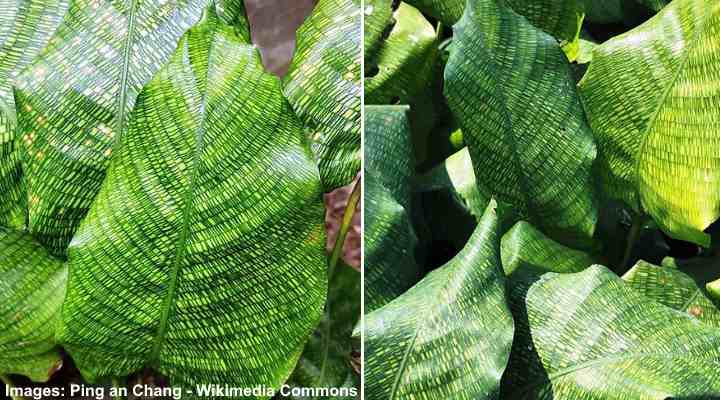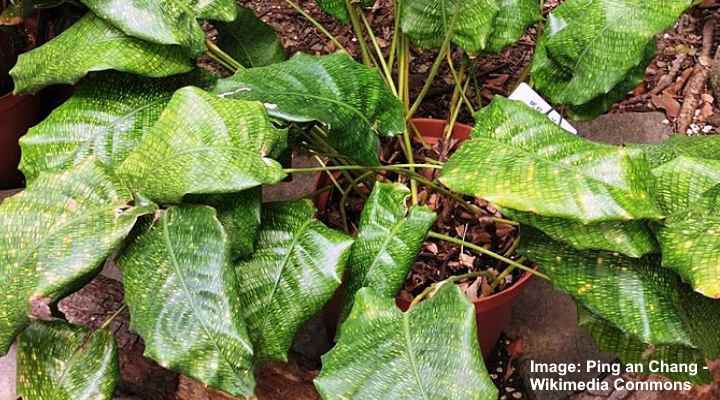Calathea Musaica (Network Plant): Care and Growing Guide

Calathea musaica is a popular tropical houseplant with intricate patterns on glossy green leaves. The unusual mosaic patterns on Calathea musaica are why this easy-to-care-for evergreen plant is called the network plant. The brightly-colored green and yellow leafy foliage of this Calathea species add aesthetic appeal to rooms, offices, and any indoor space.
This article is a complete care guide for growing Calathea musaica at home. In addition to helpful growing tips, you’ll find out how to resolve many growing issues concerning Calathea musaica network plant care.
How to Care for Calathea Musaica (Calathea Network)— Overview
To care for Calathea musaica, grow the plant in bright indirect sunlight and a well-draining fertile potting mix. Water the network plant when the top layer of soil is dry, mist the leaves regularly to increase humidity, and keep the temperature between 65 and 80°F (18 – 27°C).
Facts About Calathea Musaica (Network Plant)

Calathea musaica (network plant) is identified by its decorative mosaic-like leaf patterns
Calathea musaica is a plant native to the tropics in the genus Calathea and family Marantaceae. There are over 300 calathea cultivars, and the Calathea network is one of the easiest to care for. This species of plant thrives in indoor environments where it enjoys average room temperatures and humidity.
As an ornamental plant, Calathea musaica is prized for its light green foliage. The delightful oval leaves have an impressive network of patterns that, close up, almost look like binary code. It gets its botanical name due to these mosaic-like markings on its light green leaves.
Like many Calathea species, the Calathea musaica is a clump-forming plant. This charming houseplant grows to about 2 ft. (0.6 m) tall. Generally, calatheas are not fast-growing indoor plants, but getting the growing conditions right will ensure that they grow faster.
Calathea musaica is also a type of tropical flowering plant. In their native habitat, network plants produce tiny white flowers on the end of stems. Like most Calathea, network plants rarely flower indoors. But don’t worry, compared to the beautiful bright foliage, the flowers are insignificant.
Other varieties of Calathea include Calathea orbifolia, pinstripe Calathea (Calathea ornata), and the peacock plant (Calathea makoyana).
If growing conditions are not ideal, Calathea musaica can exhibit leaf curling, develop brown leaf tips, or suffer from drooping leaves. At the end of the article, you’ll find out how to care for these Calathea care issues.
Calathea Plants vs. Prayer Plants
Calathea musaica is in the same family as prayer plants (Marantas), and they share similar characteristics. Similar to prayer plants, Calathea musaica raises its leaves in the evening in a prayer-like pose. This unusual plant leaf movement is a process called nyctinasty. The leaves close due to darkness when the plant goes to “sleep.”
Calathea Musaica — Network Plant Care Guide
Network plants (Calathea musaica) are generally easy-care houseplants. All you need to do is ensure it grows in adequate light, water the plant when the soil is partially dry, and frequently mist the leaves. What else should you do to care for this tropical indoors potted plant?
Here is a detailed guide to Calathea musaica care.
Light Requirements for Growing Calathea Musaica Indoors

To care properly for Calathea musaica houseplant and to maintain its intricate leaf pattern, place it in bright indirect light
Calathea musaica thrives in bright light, protected from direct sunshine. Growing in tropical jungles, Calathea plants grow on the forest floor in dappled sunlight. Adequate light is vital for the plant to keep its bright foliage and intricate mosaic patterns. Too little light can result in leaves becoming darker green.
The best location to grow Calathea musaica indoors is on a north- or east-facing windowsill. There, the plant will avoid the intense midday or evening sunlight that could burn its leaves and turn them yellow. In a south- or west-facing room, keep the plants in partial shade and away from the window.
Because they love humidity, Calathea musaica is an ideal plant to keep in the bathroom.
The Best Soil Type for Healthy Calathea Musaica Growth
Calathea musaica grows best in potting soil that has excellent drainage and holds some moisture. To create an ideal potting mix, combine one part regular houseplant soil, two parts peat moss, and two parts perlite. Alternatively, you can use any commercial potting mix as long as it is fast-draining and has plenty of organic content.
Network plants are not houseplants that survive drought. Adding organic matter such as peat moss to the soil mix helps to hold enough moisture and provide essential nutrients to encourage healthy growth. Amending the soil with perlite improves drainage, helping excess water to flow freely through the soil.
In addition to using a fast-draining potting mix, you should ensure that the plant pot has drainage holes.
How to Water a Calathea Musaica Properly

Water Calathea musaica plant when the top of the soil dries out
Calathea musaica needs watering as often as the top 1” (2.5 cm) of soil dries out. In the growing season, Calathea plants may need watering weekly. In winter, you should water the tropical plant less frequently. It’s vital always to use filtered or distilled water to hydrate your plant. This helps ensure that a buildup of tap water chemicals don’t cause the leaf tips to turn brown.
The best guide for when to water network plants is soil dryness. So, always check that the soil is partially dry before watering. The goal of watering Calathea plants is to keep the soil moist but not soggy.
Use the drench and dry method to water Calathea network plants. When the top part of the soil is dry, run enough lukewarm, filtered water evenly through the potting soil. Allow all the excess water to drip out the pot’s drainage holes before placing it back on the saucer. This plant watering technique ensures the soil is always moist without being too damp.
Top care tip for watering Calathea musaica: Leave water out in a jar for 24 hours before watering your plant. This allows chemicals in tap water to evaporate and the water to reach room temperature.
Temperature Requirements for Growing Calathea Musaica
Calathea musaica thrives in average household temperatures. Keep the tropical houseplants in indirect sunlight to prevent them from becoming too warm. The ideal temperature range for Calathea musaica is 65°F to 80°F (18°C – 27°C). It’s also vital to place Calathea pots away from drafts, radiators, or warm air vents.
Calathea musaica grows outdoors in USDA zones 9 and 10. The minimum temperature for these warm-loving plants is 50°F (10°C). If you take potted Calathea plants outside in the summer, bring them back indoors when temperatures drop below 60°F (15°C).
How to Get Humidity Right for Properly Calathea Musaica Care

To grow well, Calathea musaica needs high humidity and requires regular misting
Calathea musaica network plants thrive in high humidity of 50 percent or more. Prevent crispy leaves from developing by misting Calathea leaves regularly. Alternatively, you can place the plant pot on a water-filled pebble tray, use a room humidifier, or group houseplants together to boost room humidity levels.
Misting network plants leaves increases humidity, but only temporarily. Depending on your home’s humidity—which is probably below ideal—you’ll have to mist every other day. Misting Calathea plant leaves has the added advantage of keeping spider mites and fungus gnats away—household pests that thrive in dry conditions.
Calathea Musaica Network Plant Growth Rate
Network plants have a medium growth rate when grown in ideal conditions. For rapid growth, Calatheas need bright indirect light, fertile, moist soil, and high humidity. You may notice slow growth if the plants are in continual shade, arid conditions, or are infested by plant pests.
Fertilizing Calathea Network Plants
Calathea musaica is not a heavy feeder. However, the network plant can benefit from applying diluted houseplant fertilizer two or three times a year. Dilute the liquid fertilizer to half strength and apply after watering your plant. You can also use a suitable organic fertilizer to provide necessary plant nutrients for healthy growth.
Here are a few handy care tips for fertilizing Calathea musaica plants:
- Never apply liquid fertilizer to dry soil, or you may burn the roots.
- Only apply fertilizer during the growing season—once in early spring, then at the start and end of summer.
- Flush the soil every so often with lukewarm distilled water to remove a buildup of mineral salts.
Repotting Calathea Musaica

You can repot Calathea musaica every two years to ensure healthy plant growth
Calathea musaica requires repotting every two years in spring. Choose a pot one or two sizes larger than its current one. Repotting network plants in a bigger container gives the roots more room to grow, you can refresh the potting soil, and check the roots for signs of disease.
To replant Calathea musaica (network plant) remove it from its container and shake the loose soil from its roots. Try to untangle the roots and gently and look for brown, mushy roots – trim as necessary. Half-fill the new pot with an appropriate potting mix and plant it in the new pot. Make sure the network plant is growing at the same height as before. Fill the remaining space with soil and water thoroughly.
Top care tip for Calathea musaica: Two signs your network plant needs repotting are roots poking out the pot’s drainage hole and slow-draining potting mix.
Pruning Network Plant Leaves
Calathea musaica requires very little—if any—pruning. Typically, you only need to trim off dead or decaying foliage or leaves that have turned brown. Prune the dead foliage by snipping the stems near the soil line.
How to Propagate Calathea Musaica
Calathea musaica propagation is by root division. Propagate your leafy foliage plant by removing it from its container and dividing the new growth segments from the main root. You can then place the new plant sections in a loose, well-draining fertile potting mix to start growing a new plant.
Always propagate network plants in spring and avoid damaging any of the primary roots to prevent plant damage.
Are Calathea Musaica Plants Toxic?
Calathea musaica is not poisonous to cats, dogs, or other house pets. The ASPCA lists species of Calathea on their list of non-toxic houseplants.
Pests Affecting Calathea Musaica Growth
Spider mites are the most common plant pest affecting Calathea musaica. The first signs of spider mites are small strands of fine silky threads on leaves. In time, you may notice more pronounced webbing. However, spider mites also cause leaf discoloration and yellow patches on the glossy green leaves.
Use a neem oil solution to get rid of spider mites for good. Put 1 quart (1 l) of warm water in a spray bottle and add 2 tsp. neem oil and 1 tsp. liquid Castile soap and mix well. Thoroughly douse the network plant’s foliage with the neem oil and leave it to dry. Apply the natural insecticide weekly for best results.
Please read this article on how to get rid of plant bugs to find out how to kill other types of houseplant pests. There you will find excellent tips on eradicating thrips, dealing with mealybugs, and killing aphids.
Top care Calathea musaica care tip: Mist and wipe the leaves regularly to prevent spider mite infestations.
Diseases Affecting Calathea Musaica Growth
Calathea musaica is prone to root rot if you don’t water the plant correctly. Roots that stand in damp, soggy soil can begin to decay, rot, and develop fungal diseases. Rotting roots affect the Calathea’s growth, resulting in yellowing leaves, brown leaf tips, and eventual plant death.
Prevent root rot in all your houseplants by taking care to water them properly. Always check that the soil is partially dry before giving them a thorough watering.
If you notice signs of root rot or fungal plant diseases, it’s crucial to repot your plant. While repotting, you’ll need to prune off and discard any diseased roots. Replace the soil with a fresh potting mix, ensuring that it is only slightly moist. Then, water your plant only when one-third of the soil is dry.
If root decay is extensive and you’ve got mushy stems, you may have to cut your losses and discard the whole plant.
FAQ About Calathea Musaica Plant Care
Despite being a tropical houseplant that requires little care, a few issues can affect Calathea musaica growth.
Why are leaves on my Calathea musaica turning brown?
Network plants can develop brown leaf tips or margins due to a lack of humidity or overwatering. Brown leaf tips are not uncommon on Calathea plants. To prevent more leaves from turning brown, mist the leaves regularly and ensure the plant isn’t near a heat vent or radiator.
Like most houseplants, Calathea musaica doesn’t like sitting in soggy soil—another reason for leaves turning brown. So, make sure you’re following the best houseplant watering tips to keep the potting soil moist but not saturated.
Another reason for Calathea brown leaf tips is using tap water to water your plants. Tap water contains chemicals that build up in the soil. Over time, the glossy green and yellow network plant leaves develop brown, crispy edges. To prevent this, use filtered or distilled water at room temperature.
Calathea musaica plant leaves are curling
A lack of water often causes Calathea network leaves to dry out and curl. If the soil is dry right through, you’ll need to thoroughly drench the soil to help bring the plant back to life.
Calathea musaica leaves also curl due to a lack of humidity. You can place the Calathea plant pot on a tray of pebbles and water to create a humid growing environment. Or you can mist the plant leaves every other day to hydrate them and prevent curling.
However, if the top layer of soil feels soggy, overwatering your plant could have caused the leaves to curl. So, hold off watering until the top third of the potting mix is dry.
How can I revive a dying Calathea musaica network plant?
To help save a Calathea plant that shows signs of dying, find out what is stressing the plant. If watering issues are causing crispy leaves or soggy roots, adjust your watering schedule appropriately. Also, you should check underneath the foliage to spot signs of common houseplant pests. Treat the plant with a natural insecticide to help revive your plant.
Why do Calathea musaica leaves turn yellow?
Several problems can cause Calathea musaica leaves to start yellowing. The most common issues are overwatering the plant. However, too much sunlight, extreme temperatures, drafts, and nutritional soil deficiencies can all lead to yellow Calathea leaves. You will have to trim off the yellow foliage and resolve the underlying issue to try and save your plant.
Why is my Calathea musaica droopy?
Calathea musaica network plants start wilting when they lack water. Leaves start drooping as the plant uses up its reserves. You may also notice that leaves are curling. If this is the case, soak the soil with lukewarm water to help bring it back to life and restore its vigor.
Related articles:
- Prayer Plant (Maranta Plant): Ultimate Care Guide
- Coleus Care: How to Grow Colorful Coleus Plant
- Nerve Plant (Fittonia Plant): Caring for Vein Plants
